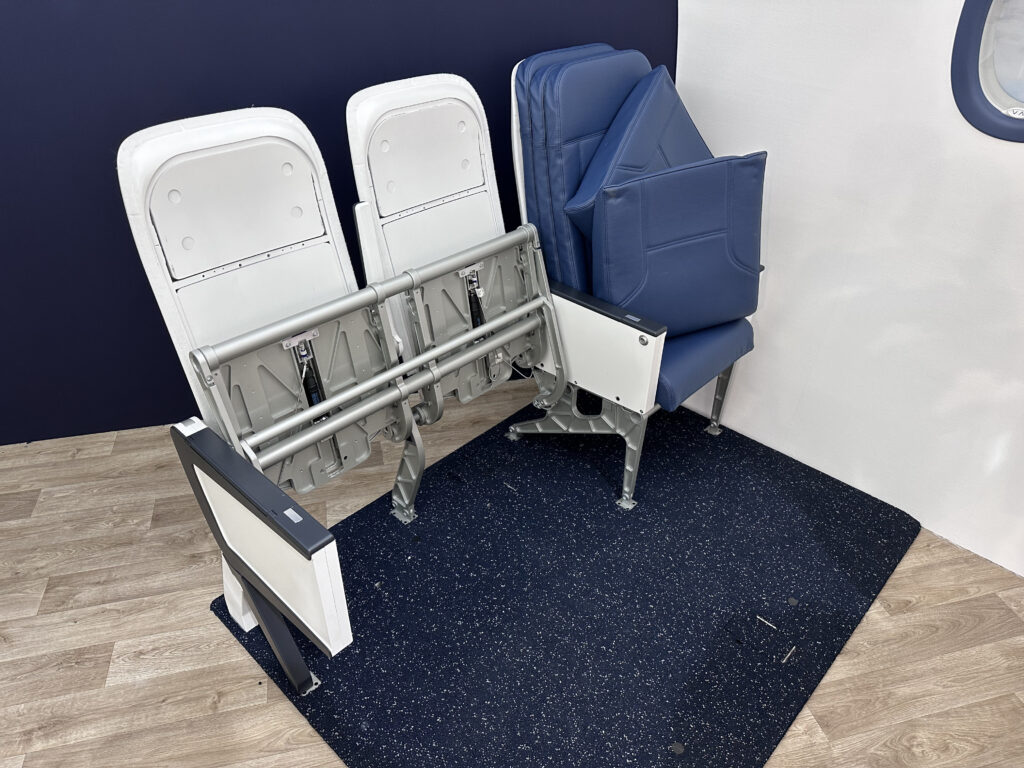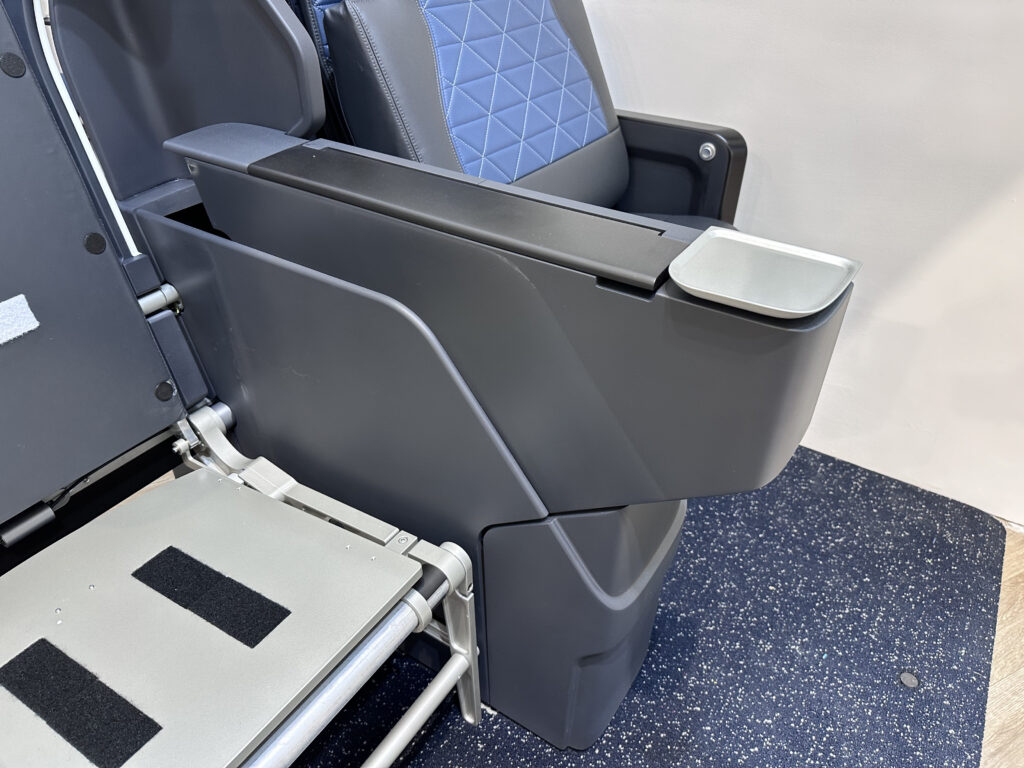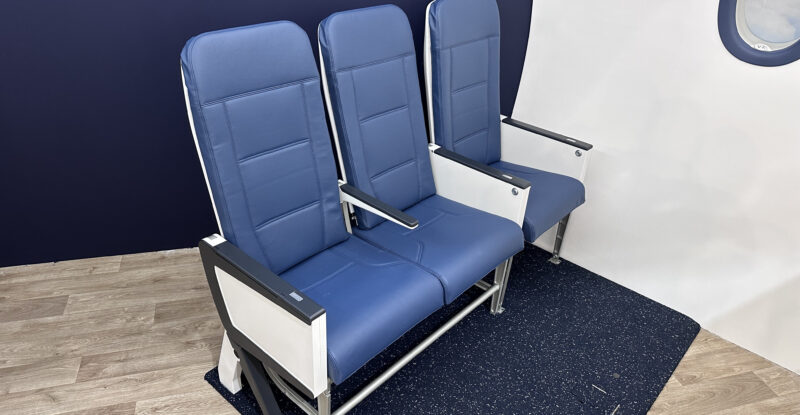 HAMBURG — Air4All, the consortium designing a revolutionary and long awaited wheelchair seating system for aircraft that will allow wheelchair users to travel in their own chairs, is showing off a brand new economy class version of their wheelchair restraint system at this year’s Aircraft Interiors Expo.
HAMBURG — Air4All, the consortium designing a revolutionary and long awaited wheelchair seating system for aircraft that will allow wheelchair users to travel in their own chairs, is showing off a brand new economy class version of their wheelchair restraint system at this year’s Aircraft Interiors Expo.
A development of the recliner version (for US domestic first, widebody premium economy, or similar cabins), the economy Air4All essentially flips up the aisle seat and the seat immediately adjacent (middle in a row of 3 or window in a row of 2) to enable a wheelchair to be secured using the same system as the recliner version.
This is a much-welcome addition to the Air4All product range, enabling more wheelchair-using passengers to travel in their own chairs rather than experience the problematic transfer process and to risk their wheelchair being damaged by baggage handlers.

The cushions — which can be stowed in overheads or closets — are removed to enter wheelchair mode. Image: John Walton
With the closer row positioning of economy, the key question that springs immediately to mind is how the consortium is dealing with the row-to-row head injury criterion (HIC) requirements that are often solved using seatback breakover.
In response to RGN questions, Nigel Smith, managing director and head of design at SWS Certification Services, explains that “seatback breakover is not a requirement but one design employed to demonstrate compliance with row to row HIC [25.562(c)(5)], which doesn’t always work first time. The Air4All seat will have a seatback design that will ‘delethalize’ the impact surface area for the occupant behind and have suitable flexibility within the structure to help attenuate the head impact.
“Many ‘Y’ [economy] class seats have fixed seatbacks with no recline and due to the lower row-row seat pitch and the area of impact being higher up the seatback, the occupant has less distance to travel before impact, which helps reduce the impact velocity and HIC.”

With the lesser depth of the economy seatback compared with the recliner version, there’s actually more wheelchair space in this version. Image: John Walton
In practice, Smith says, “Air4All will have the same features in the seatbacks as the operators existing seats, which will already be compliant and may not have a breakover feature. There are also other design features which can be employed to help reduce HIC, such as bottom cushion profile, polyester seatbelts instead of nylon, ‘Y’ lapbelts, shoulder restraints, etc. We have been involved with certifying many seat types with direct seatback head contact without a breakover feature, and seats with fixed rear screens.”
The first generation recliner version, meanwhile, is progressing through its design process towards certification and commercialisation.

The functionality has been evolved and simplified, with the cushions here too being stored overhead or in a closet. Image: John Walton
Delta Flight Products’ spokesperson tells RGN that “DFP has made significant progress on the domestic US first class option, including enhancing the features that are available to passengers, increasing the width of the seat and slimming the plinth that would be installed via the seat track.
These changes were made as a result of feedback received from stakeholders and Delta’s Advisory Board on Disability. The product on display at AIX is an updated prototype that features these enhancements.”

A key change from last year’s version is that the armrest raises independently and can be adjusted to more positions to suit the wheelchair user. Image: John Walton
On the regulation side of things, DFP spokesperson says, “DFP has had preliminary discussions with regulators to provide guidance in ensuring that the final design ca achieve certification. We are currently working towards the goal of having the seat meet FAA, EASA and UK CAA requirements. Testing to provide regulators with all necessary data will follow.”
Consortium member Chris Woods confirms to RGN that the consortium is planning to achieve TSO certification by the end of 2024 or the beginning of 2025.
Reviewing the seat in a preview on the Delta Flight Products stand at AIX, it was clear how much iterative work had gone into the recliner version, and how much readacross there is to the economy equivalent.
This is incredibly impressive work, and the entire Air4All consortium deserves every plaudit for the quality of this solution, which will expand safe, confident and comfortable travel to an almost incalculable number of wheelchair users.

Up front, the recliner version has had the full Delta domestic first colour, materials and finish treatment. Image: John Walton
Related Articles:
- Air4All wheelchair seat space wows with simplicity and elegance
- Collins to unveil onboard wheelchair accommodation at AIX
- Delta Flight Products partners to take Air4All through development
- How Diehl and HAECO have reimagined the single-aisle premium cabin
- ST Engineering gains traction for ACCESS accessible lavatory
- Ideas abound as US DOT eyes wheelchairs in the cabin
- NIAR students and Collins propose wheelchair-in-the-cabin solution
- Design enables wheelchairs in cabins without reducing seats
Featured image credited to John Walton











